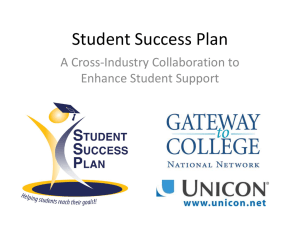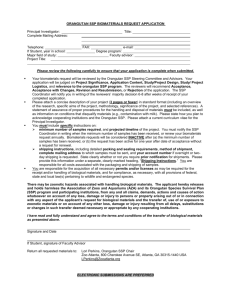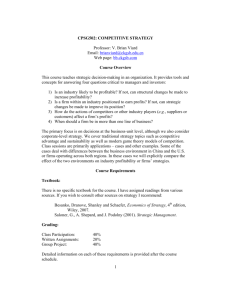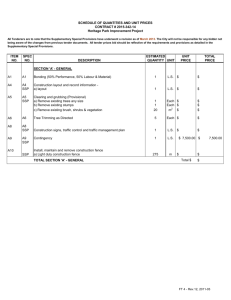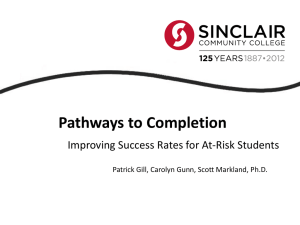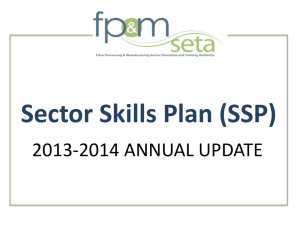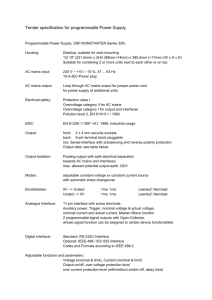Instructional design
advertisement
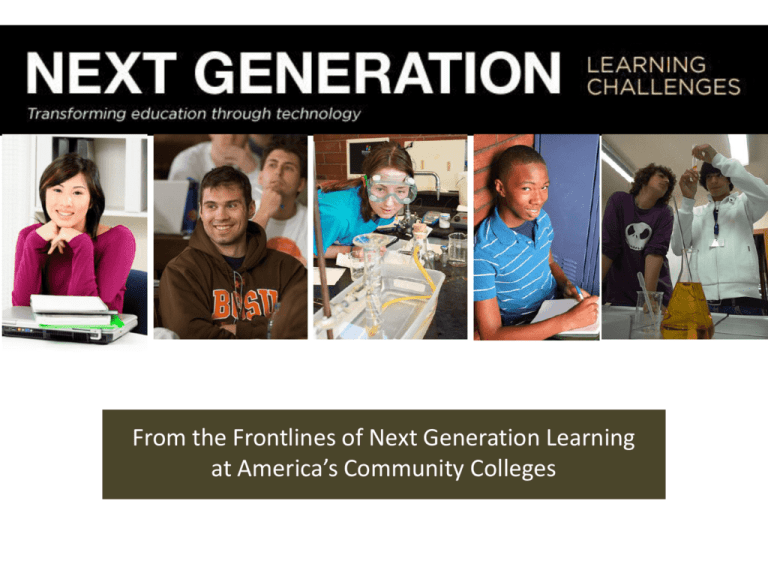
From the Frontlines of Next Generation Learning at America’s Community Colleges August 4, 2011 The partnership: The Problem We’re Trying To Address: Critical shortcomings of U.S. education delivery (K-16) Instructional design: Depersonalized one-size-fits-all curricular and instructional approaches Lack of coherence and relevance to unlock students’ engagement and motivation Achievement goals and measurement: Broad, shallow content acquisition at the expense of deeper learning of sophisticated knowledge and skills Time-based progression and expression of accomplishment in seat-time rather than through a nationally accepted competency-based model System design/performance: Inequitable opportunity to learn for students of low economic means Lack of comparability and transferability of data, records and credentials Consistently escalating costs with little or no improvement in student outcomes Deeply embedded practices, structures, and policies that limit the opportunity and impact of reform Lack of R&D/capital-markets infrastructure to enable reform, relative to other sectors 3 Core Beliefs and Guiding Assumptions WHO WE ARE A partnership designed to leverage the power of technology to transform education to meet students’ and society’s needs in the 21st century. WHAT WE BELIEVE VISION: This goal requires the fundamental transformation of education practices, policies, and structures. Incremental change will not suffice. GUIDING ASSUMPTION: Technology has the power to disrupt the status quo, and is beginning to do so in education. CORE OPERATING PRINCIPLE: This disruption cannot be “managed” using traditional, top-down processes. It will arise from field-based innovation and achieve scale through distributed networking within and across communities of practice. Our role is to catalyze and support those innovations and that networking. Today’s Speakers • Andrew Calkins, Deputy Director, Next Generation Learning Challenges, EDUCAUSE • Stella Perez, NGLC Founding Partner, COO, League for Innovation in the Community College • Mike Davis, Associate Vice Chancellor, City Colleges of Chicago • Russ Little, Manager, Web Systems, Sinclair Community College • Geri Anderson, Associate V.P. & Provost, Colorado Community College System City Colleges of Chicago At a glance • District of 7 college campuses. • Over 120,000 in programs • Roughly 60,500 in college credit programs. • Diverse student body – – – – 67% female (avg. age 27) 44% are African American 20% are Latino/a 31% receive financial aid Remedial Needs • 78% of students report transfer as their educational goal. • 95% of incoming high school students require math remediation. • 1% of students that require remediation in English, Reading, and Math obtain an Associates Degree. Map of Math Courses at CCC Math Placement Exam (COMPASS) Not College Ready College Ready Liberal Arts Pathway STEM Pathway (AS) Pre-Calculus Math 140 – 143 Calculus Math 207 (Developmental) (AA and others) General Education Math 118 Math 098 Beginning Algebra Not College Ready (Foundational Studies) Foundational Studies 1-4 Math 099 Statistics, Math for Educators Intermediate Algebra with Geometry Ready for College Level Math Ready for Math 098 Placement and Pass Rates in Math 098 and Math 099 Initial Placements 80% of students who take COMPASS Algebra and PreAlgebra place into either Math 098 or Math 099. Math 098 students are dramatically less likely to succeed. No Remediation 5% FS Math 15% Math 099 30% Math 098 50% Withdrawal and Completion Rates 80% 70% 60% 50% Math 098 40% Math 099 30% 20% 10% 0% Pass Rate Drops In both courses, about 32% of students receive nongrade designations. Of those that receive a grade, initial pass rates are significantly higher in Math 099 – about 70%, versus 50% in Math 098 How a Student Navigates the Pathway Success Depends on the Student's Pathway 80% 70% Placed into 99 60% Completed 98 50% 40% 30% Students in 099 coming out of 098 are doing worse overall than students testing into Math 099 in the first place, both in terms of retention and completion. Students Reaching Milestones 20% 10% 100% 0% Pass Rate Complete Rate Drop Rate 90% 80% 70% Completing Math 098 is a major barrier between a student and successfully earning a credential or transfer. 50% of all incoming students face this barrier, but fewer than 20% of them will overcome it. 60% 50% 40% 30% 20% 10% 0% Enroll in Math 98 Complete 98 Successfully Register for Math 99 Complete 99 Successfully 9 Math On Demand + Early Alert System Nature of the Innovation Intentional fast-track preparation for student to move into college level Math classes. Increased access to Tutors and Advisors during and outside of class Math on Demand + Early Alert (MOD+) Increased use of technology in and outside of classes Targeted professional development and common assessment tools. Blended Learning Model Approach • Increases use of technology in and out of the classroom without relying on it for complete instruction delivery. • Flexible model allows for variable resources to deliver high quality instruction. • Cost effective, scalable, and sustainable in a large district. • Cost savings allow for investments in early alert systems, and embedded student supports (tutors and advising). • Expect to impact 10 sections of 30 students on 6 campuses in the coming year. What is the Student Success Plan (SSP)? The SSP is a software system and process for student success, designed to increase the persistence, success, and graduation rates of targeted students. Through holistic counseling, web-based support systems, and intervention techniques, students who are at risk of failing in college are identified, supported and monitored. Data is collected and analyzed to make decisions about future efforts. Russ Little - Sinclair Community College Reasons We Created SSP • Improve at-risk student retention & success • Increase graduation rate of at-risk students • Implement a systematic, comprehensive counseling and intervention process • Implement an integrated Early Alert intervention process • Develop and maintain a comprehensive resource of community and college referral sources for addressing challenges to student success and retention. • Develop a web-based counseling record (case) management system • Remove silos between offices that support students • Create self help tools to connect students to resources that help them overcome challenges to their success SSP Software System SSP Case Management Software • Journal and create Action Plans, review student records • Historical view of all interactions with student • Specific tools; Counseling, Disability, Displaced Worker …etc Early Alert • Faculty & Staff send early alerts from a roster or search tool • SSP software notifies and routes alert to Support Staff • Feed back loop to let Faculty or Staff know the outcome Student Interface • Student intake form to collect student data • Self Help Guides to assist student in finding available resources • Action Plan / Task List – Monitor student progress • Connection to Coach – Student contact point to advocate Student Information System (SIS) Integration • Connects your student data to SSP • Builds rosters for faculty members automatically for Early Alert Example Sinclair SSP Outcomes • Quarter to Quarter SSP Retention (Fall 09 to Winter 10) – • Fall to Fall SSP Retention (Fall 08 to Fall 09) – • Transitioned SSP students (students who have completed the SSP process) had a 51% higher rate of retention compared to students who qualified for the program but did not participate and a 30% higher rate of retention than students not designated “at risk”. Next Quarter Retention Rate of Minorities – • Transitioned SSP students (students who have completed the SSP process) had a 23% higher rate of retention compared to students who qualified for the program but did not participate and a 21% higher rate of retention than students not designated “at risk”. Minority Transitioned SSP students had an 18% higher rate of retention compared to minority students not designated “at risk”. First Term Grade Point Average – Transitioned SSP students had an average grade point average of 3.06 compared to 1.65 for students who qualified for the program but did not participate and 2.42 for students not designated “at risk”. Transitioned SSP = students who have completed their SSP process and have met the transition criteria (Challenge issues resolved such as childcare and transportation, decided on a major, GPA 2.0 or higher, passed 1st quarter Academic Foundation classes ) SSP Student Groups at Sinclair • Originally designed to manage “At-Risk” student populations, SSP has been expanded to provide Case Management to many more student groups: • • • • • • • Counseling Services Disability Services High School Students Distance Learning Specific Campus Locations Displaced Workers And many more….. SSP Awards & Adoption • 2004 Educause Excellence in Information Technology Solutions Award • 2005 Macromedia Higher Education Innovation Award • 2005 National Council for Student Development Exemplary Practice Award • 2005 NCSD and League for Innovation Terry O’Banion Shared Journey First Place Award • 2006 MetLife Best Practice College Award • 2007 Bellwether Finalist Award – CC Futures Assembly • 2008 NACADA Program Merit Award • 2008 NASPA Grand Silver and Gold Awards • 2009 NASPA Grand Gold (for Early Alert) • SSP has been adopted by 6 Community Colleges In Sinclair’s Experience Students who are involved with SSP • Are more likely to return next term • Are more likely to complete more courses successfully • Have higher GPAs • Are more likely to be enrolled two years later NGLC Grant • SSP Software to be Open Source! • Expect to have Open Source version available in 6-8 months. • Piloting current version with certain schools now, inquire if interested. • For more information / demo russ.little@sinclair.edu NORTH AMERICAN NETWORK OF SCIENCE LABS ONLINE (NANSLO) Remotely Accessible Laboratory Experiments Extending First-year STEM Opportunities Next Generation Learning Challenges The North American Network of Science Labs Online (NANSLO) was selected from more than 600 pre-proposals and 50 finalists. 15-month, $750,000 grant. The only international project funded. The Bill & Melinda Gates Foundation and the William and Flora Hewlett Foundation helped design Next Generation Learning Challenges and fund the initiative. Multiyear, collaborative initiative focused on identifying and accelerating the growth of effective education technology that can help improve college readiness and completion in the United States, especially among low-income individuals. NGLC is focused on early-stage innovations that look promising but require significant technology investments. EDUCAUSE, dedicated to advancing higher education through the use of technology, leads the NGLC initiative. The Numbers: Online Learning 21% growth rate for online enrollment far exceeds the 2% growth in the overall higher education student population 2010 Sloan Survey of Online Learning* interviewed 2,500 colleges and universities nationwide. Approximately 5.6 million students were enrolled in at least one online course in fall 2009. Nearly 30% of all students take at least one online course. Over 75% of surveyed academic leaders in public institutions report that online instructions is as good as or better than face-to-face instruction Allen, Elaine, and Jeff Seaman. Class Difference$. Rep. BABSON Survey Research Group, Nov. 2010. Web. 26 Aug. 2011. <http://sloanconsortium.org/publications/survey/class_differences>. Remote Access to Scientific Instrumentation Remote access to scientific instrumentation has been in practice for many years NASA Mars Rover and Space Station Remote Sensing in Oceanographic Study Remote Access to Scientific Laboratories Remote access to science lab equipment started in the mid-1990s in higher education Wide-spread adoption is slow Perception that “remote” is not “real” Initial cost of equipment and maintenance Technical complexity Strong student outcomes challenge perceptions Remote lab pedagogy is evolving Benefits of Remote Laboratories Remote access benefits underserved students Rural, disabled, and working students with difficult schedules can access scientific experiments 24x7 Networked laboratories promote efficiency Expensive scientific resources are shared by multiple institutions and scheduled for maximum efficiency Students enjoy benefits of remote access Extended opportunity for repeated experimentation Preferred over use of simulations Equipment and materials are controlled Access to expensive or dangerous materials Remote Labs Around the World Networks of laboratory experiments are available world-wide iLabs, MIT-based global consortia (Europe, Africa, Asia) Labshare , a consortium of five Australian universities Lila Project, (Library of Labs) a consortium of eight European universities iLough-Lab, University of Loughborough (UK) iSES, internet School Experiment System (Czech Republic) NANSLO, North American Network of Science Labs Online NANSLO Mission Statement NANSLO provides a consortium approach to the development and deployment of high-quality, modular, openly licensed courseware integrating learner-centered and immersive web-based labs using software, video and robotics for the study of science courses. NANSLO Partners Eight primary partners in the NANSLO project. Two partners, BCcampus and Colorado Community College System, bring consortium members to the project. WICHE serves as the coordinating and fiscal agent. Five other partners contribute to academic review of curriculum. NANSLO Project Objectives Developing high-quality first-semester core curriculum for Biology, Chemistry, & Physics. Designing comprehensive laboratory learning experiences which meet learning outcomes while accommodating flexible delivery options. Integrating innovative technologies for mediating science learning. Remote Web-based Science Laboratories Lab kits International Collaboration Leverage BCcampus Creative Commons License Modify the existing Open Courseware to create NANSLO laboratory curriculum Integrate NANSLO curriculum elements into Colorado Community College System courseware Partner with BCcampus to replicate technical demonstration results North Island College RWSL implementation and Creative Commons curriculum Lab Kits for Remote Student Use Students are provided with all laboratory equipment necessary for remote experimentation Physics lab kit example Remote Web-Based Science Laboratories • Software and robotic interface controlled over the Internet by students. • Students interact with and manipulate remote scientific laboratory equipment. • Class works online in small groups or individually to collect authentic real-world scientific data in real time. • Allows participation in laboratory experiments for students who may otherwise be unable to attend a traditional classroom/laboratory setting. Equipment for Remote Access Hardware Frame, Robotic Slides and Tables Robotic Positioning Slides and Rotary Tables, Robotic Arm, Spectrometer, Digital Microscope, Air Track Software National Instrument’s LabVIEW, Hardware Control Server Video/Audio Cameras, Capture Card, , Video Multiplexer, Streaming Server RWSL Overview Observation Students Observation Physical Manipulation Manipulation Internet RWSL Lab Equipment Data Communications Data Acquisition 35 Text Chat Skype Elluminate 35 Observation Pan Tilt Zoom Camera Video Streamer Video Mixer 36 Physical Manipulation Robotic Arm Linear Slides Rotary Tables Slide Loader 37 Data Acquisition Chemistry/Physics Spectrometer – properties of light such as intensity, polarization, wavelength LabVIEW Software 38 How NGLC Organizes Its Work Strategy 1: INVEST IN INNOVATION $39 million across three waves of grantmaking Strategies 2 and 3: MULTIPLY IMPACT Increase the probability and size of grantee impact through: Building evidence and a knowledge base Enabling networking and communities of next generation learning practice Strategy 4: ACCELERATE ADOPTION Advance public and leadership awareness and action towards adoption and system change Wave I: Building Blocks for College Success Wave II: Building Blocks for College Readiness Wave III: Next Gen Learning Models for College Readiness & Success April 2011 – September 2012 June 2011 – December 2012 January 2012 – June 2014 Innovations at post-secondary level in deeper learning, analytics, blended learning, and open core courseware NGL content and assessment modules to help students master 7th -9th grade math and literacy, aligned to Common Core standards Innovative, blended whole school models with radically higher student success at an affordable price Example: UCF’s Blended Learning Toolkit that includes best practices, course models, assessment and data collection protocols and “train the trainer” materials Examples: Imagine Education’s Ko’s Journey, a game-based pre-algebra program; or iCivics’ argumentation modules to advance content-based literacy and critical thinking Examples (K-12): Quest to Learn, Carpe Diem, Rocketship Examples (H.E): Kentucky Community Technical College On-line/On-demand, Western Governors University, Rio Salado Community College Wave I: Building Blocks for College Completion The Call: Solutions to improve course completion, persistence, and college completion through blended learning, deeper learning and engagement, learner analytics, and open core courseware. $10 million distributed among 29 grantees • 15-month grants, awarded April 2011 • $500,000 for open core courseware • $250,000 for blended learning, deeper learning, and learner analytics Wave I by the Numbers: 600 pre-proposals 78 community colleges 29 grants 200 institutions in all 117,000 students currently served 304,585 students by grant end $10 million in funding $5 million for follow-up Wave II: Building Blocks for College Readiness The Call: Interactive modules focused on 7th-9th grade Common Core Standards in math and literacy that can capture real-time performance data $7 million invested across 19 grantees • 15-month grants, awarded June 2011 • $250,000 for proof of concept • $500,000 for early stage adoption Wave II by the Numbers: 240 pre-proposals 19 grantees 85 organizations in all 176,000 students by grant end 2.15 million students served 5 years later $7 million in funding Wave III: Breakthrough Models For College Readiness and Completion The Call: Accelerate the development of next generation school and college models that leverage technology to significantly increase student success at equal or lower costs than current norms. $12 million ($6 million for K-12, $6 million for higher ed) • To be announced on October 5, 2011 • Twenty $150,000 incubator grants for middle/secondary models with $300,000 challenge match to follow • Six $1,000,000 grants to higher education models Wave III: Design Parameters for New Models Instructional Design Integration/blending of web-based learning (high priority: substantial percentage – perhaps 25% -- of instruction delivered online) Incorporation of Common Core standards in ways that lead to deeper learning and 21st-century skill development Personalization/adaptation Achievement Goals and Measurement Competency/standard-driven curriculum Mastery-based progression/modularization Analytics, imbedded assessment, and frequent feedback System Performance and Scalability Highly scalable design/low adoption barriers Sustainable funding model within three years High productivity staffing model/organizational structure Integration of secondary and postsecondary (a priority, not a requirement) Red = non-negotiable www.nextgenlearning.org August 4, 2011
